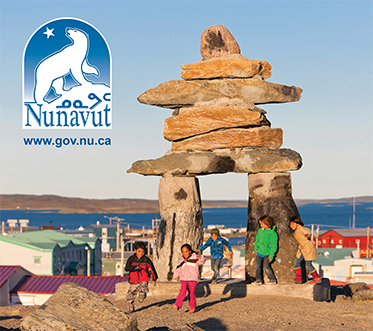Associate professor and research chair in Nunavik’s permafrost at Laval University Pascale Roy-Léveillé. (Photo courtesy of Laval University)
Mercury levels in Nunavik permafrost lower than expected: Study
Researchers look at Kangiqsualujjuaq after higher levels of dangerous compound found in Alaska
Mercury levels in Nunavik’s melting permafrost are not as high as expected, according to results from a study recently released by Laval University.
Researchers were drawn to Nunavik after a study carried out in Alaska in 2018 found permafrost there and across the northern hemisphere contained higher mercury levels than any other soil on the planet, including in the oceans and atmosphere.
Exposure to mercury, even low levels but over an extended period, can be harmful to human health.
The 2018 study sent a shockwave through the scientific community, and caught the attention of Pascale Roy-Léveillé, an expert in Nunavik’s permafrost.

A permafrost sample that was gathered near Kangiqsualujjuaq in 2023. (Photo credit of Sarah Gauthier and Université de Laval)
She felt that such a large-scale study often does not present the reality at the community level. So with her team from the Centre for Northern Studies at Laval, which is based in Quebec City, she went to Kangiqsualujjuaq to see if Nunavik’s soil also had that much mercury in it.
“Nunavik’s permafrost is very different from Alaska,” Roy-Léveillé said in a French interview.
She said Laval’s study, released in April, found there is less organic material in Nunavik’s permafrost, meaning the amount of mercury attached to the organic material is also lower than that found in Alaska.
“In a way, this was good news compared to the global estimate we had before,” she said.
Roy-Léveillé said the process for mercury to be created in permafrost is twofold. The first aspect is the mercury deposit itself, which occurs naturally over time.
Then for the mercury to be released, it must be attached to a micro-organism present in organic material that’s often related to dying plants, which creates methylmercury.
Methylmercury is a neurotoxin that can infiltrate the food chain and poses risks to human health if consumed, according to Laval’s study.
Roy-Léveillé found that both the mercury level and the amount of organic material was low in water basins created by the melting permafrost near Kangiqsualujjuaq.
“There is a resilience to this ecosystem,” Roy-Léveillé said, adding her team saw that plant life such as moss quickly took over the permafrost ponds, stabilizing the rate of methylmercury creation.
“This was the work behind this study, to say that the melting of permafrost won’t be the end of the world,” she said.
However, she believes more studies should be done, specifically examining how the mercury trickles into waterways and how it may impact fish life in Nunavik waters.
“We applied for funding to look at the lakes near communities, where there is permafrost degradation nearby,” Roy-Léveillé said.
In that study, she intends to involve local communities much more, such as in gathering fish samples.
If anyone in Nunavik ever sees anything that worries them in fish they have caught, or if there is a lot of permafrost near where they live, she encourages them to contact her research team.
“I wish that these voices be heard, so that the scientific community can lean on problems related to lived experiences of the people who live in these regions,” Roy-Léveillé said.







All ways something new to worry about !!
Yup… dead fish found at lake near inukjuak last fall season.
METHyemercury is bad GR, don’t experiment with it like nicotine patches 🤑
Permafrost is real gang. And nothing will stop it from thawing. Start building on rock and leave the pad to the gravel pit.
That’s a perfect picture of of why , when how and where, don’t forget what is low mercury levels? A symbol of hope and good health folded into its own arms.